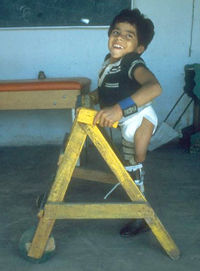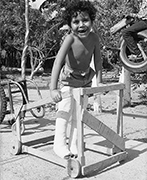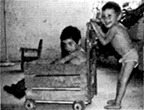Hesperian Health Guides
Walkers
 |
 |
 |
| Julio has strong arms and good body control. He can use a simple low walker. | Lico has weak elbows and poor balance or body control. He needs a higher walker with armrests. | Anna has weak legs and poor balance. She does best with underarm crutches built into the walker. |
The above walkers can be made with 2 cm x 4 cm boards (such as those used on roofs to hold tiles), or thin trees or branches. The wood or plywood wheels roll easily when little weight is on them (when child pushes walker) but have a braking action when child puts full weight on them (when taking a step).
 |
SIDE VIEW | FRONT VIEW |
 Diagonal support adds strength.
Round edges of handle.
nails
wood or plywood wheel
piece of steel construction rod (re-bar)
Triangular construction adds strength. | ||
Finding the design that works best for a particular child often involves experimenting and changing different features.
| For example. Carlota has poor body and hip control, and tends to fall through the space between her arms when the handgrips are upright. |  |
A higher walker with a bar as the handgrip works better for her. |
 |
 |
| This walker with slanting bars lets a child hold it at the height that he finds works best. |
Contents
Other walker designs
| WALKER MADE FROM CANE, RATTAN, OR BAMBOO | WOOD WALKER | ||
| Design from Rattan and Bamboo Equipment For Handicapped Children, J. K. Hutt |  |
Design by Don Caston |  |
| Joints can be tied with cane, ribbon, nylon string, strips of car inner tube or whatever. | Wood walker for a child whose legs need to be held apart. | ||
Note: A walker with no wheels is very stable but harder to move. |
 |
 |
 seat |
| A walker with 2 wheels and 2 posts is fairly stable but easy to move. | A walker with 3 or 4 wheels is very easy to move but can easily roll out from under the child (unless the child is seated). |
WALKER MADE FROM SOLID IRON ROD (RE-BAR) WITH ARM RESTS — WELDING REQUIRED


Cut and bend rod. |
 Assemble walker.
padding or hand-grips from crutches
slider
rubber
wood wheel |


SIMPLE WALKER MADE FROM SOLID IRON ROD (RE-BAR)— WELDING REQUIRED
| Design from Simple Prosthesis Manufacture, Chris Dartnell. | Cut and weld rod. | SIDE VIEW | FRONT VIEW |

arms in half-bent position |
 | ||
CART WALKER
| Design from Finnie’s Handling the Young Cerebral Palsied Child at Home | ||
 |
 |
 |
| The added weight in the cart can help the child stand firmly—and makes learning to walk more fun. | As the child progresses, he can change his grip from the front bar to the side bars. | Wheels on this cart walker are made from the round seed pods of a tree in Mexico, called Hava de San Ignacio. |
ROLLER SEAT AND TRICYCLE WALKERS
 |
Useful for a child with cerebral palsy who “bunny hops” (crawls pulling both legs forward together). Seat holds legs apart. The chimney helps child keep his arms up and apart. |

Stable for the beginner |
| Design from Finnie’s Handling the Young Cerebral Palsied Child at Home |
WALKERS FOR SITTING AND STANDING

SPIDER WALKER

SADDLE-TYPE WALKER



